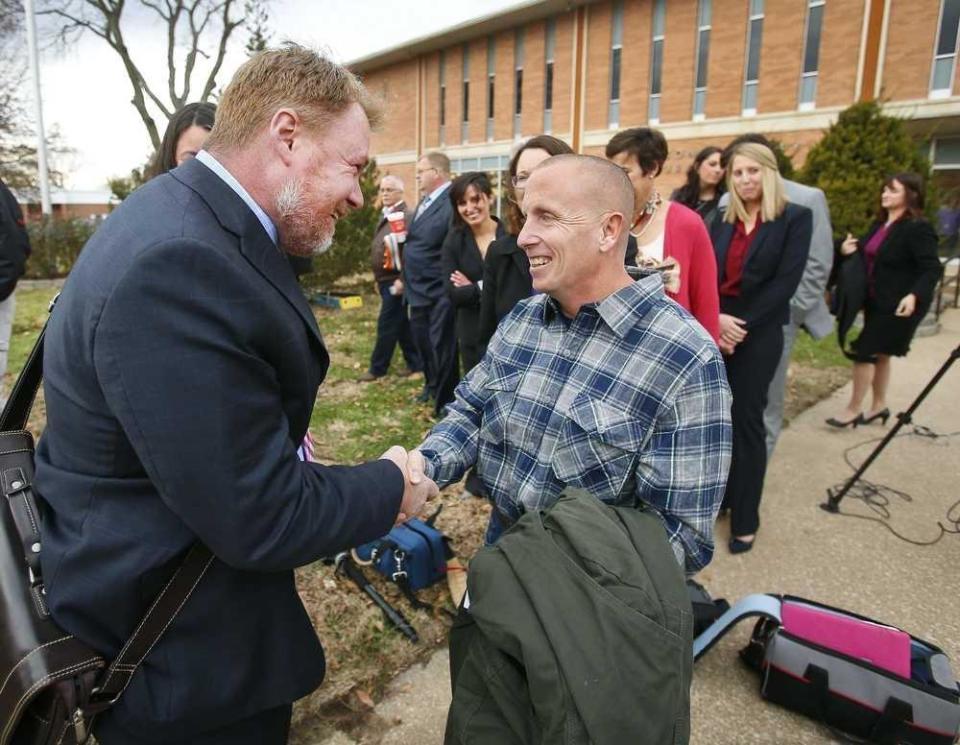KBI agents helped wrongfully convict him, Floyd Bledsoe alleges. He's seeking $24 million
- Oops!Something went wrong.Please try again later.
Floyd Bledsoe, wrongfully convicted of a 1999 Jefferson County sexual assault and murder, is asking for $24 million to $48 million in compensatory damages from the four remaining defendants in a lawsuit he is pursuing.
He asks that three defendants — an attorney and two former Kansas Bureau of Investigation agents — also be required to pay punitive damages of $100,000 each for allegedly showing malice and/or reckless indifference to his constitutional rights.
Those figures were shared in a federal court pretrial order issued Thursday by U.S. Magistrate Judge Angel D. Mitchell, who is presiding over a civil lawsuit Bledsoe is pursuing.

Who is Floyd Bledsoe suing, and why?
Bledsoe, 46, was wrongfully imprisoned for 16 years for the murder and sexual assault in 1999 of his sister-in-law, 14-year-old Camille Arfmann, who was fatally shot north of Oskaloosa.
He was released from prison in 2015 after DNA evidence proved he couldn't have committed those crimes and his older brother, Tom Bledsoe, wrote notes confessing to them before he died of suicide by asphyxiation.
Bledsoe is pursuing a lawsuit against Jim Woods, Terry Morgan, Michael Hayes and the estate of George Johnson, who died in 2020.
Woods, Morgan and Johnson were agents with the KBI, which helped investigate Camille's death. Hayes was criminal defense attorney for Tom Bledsoe.
Why is Bledsoe asking for $24 million to $48 million?
Bledsoe's lawsuit says authorities fabricated evidence against him and suppressed evidence in his favor to wrongfully convict him of Camille Arfmann's murder.
During his years in prison, Floyd Bledsoe was kept in "harsh, dangerous and isolating" conditions, his lawsuit petition said.
"Plaintiff had been convicted of a horrific crime — sexually abusing and killing a young girl — and had to endure the humiliation and injustice of being wrongly branded a 'sex offender' and a murderer," it said. "Because Floyd had been sentenced to life in prison, he feared that he would die alone inside the prison walls."
What's happened so far with Floyd Bledsoe's suit?
Bledsoe filed suit in May 2016 alleging his constitutional rights had been violated by Jefferson County and 11 named defendants.
The Jefferson County Commission last April agreed to pay a $7.5 million settlement to Bledsoe in exchange for his dropping his suit against that county and all lawsuit defendants who were Jefferson County employees.
The only defendants not dropped from the suit were Hayes, Woods, Morgan and the estate of Johnson.
The state of Kansas in 2019 acknowledged Bledsoe had been wrongfully convicted and granted him total compensation of $1,038,526.95.
When will Floyd Bledsoe's civil case go to trial?
The order Mitchell issued Thursday keeps in place previously made arrangements calling for the trial in Bledsoe's suit to begin at 9 a.m. April 2, 2024, in Kansas City, Kan. The trial is expected to last seven to 10 days, it said.
In the meantime, the order said, "the parties currently believe the prospects for settlement of this case are uncertain."
A private mediation session between the two sides was set for June 28, 2023, the order said. It shed no light on what may have resulted from that.
How did Floyd Bledsoe know Camille?
Camille was living at the time of her death with Floyd Bledsoe; her sister, Heidi Bledsoe, who was then married to Floyd Bledsoe; and Floyd and Heidi Bledsoe's two young sons. Heidi Bledsoe later divorced Floyd Bledsoe.
Floyd Bledsoe was a hired hand at a McLouth dairy at the time of Camille's death. Tom Bledsoe, then 25, was a security guard at Lawrence's Farmland Industries.
How many times was Camille Arfmann shot?
Camille, a student at Oskaloosa High School, died after being shot four times, including once in the back of the head. Soon afterward, Tom Bledsoe confessed to the crime.
But Jefferson County officials responded by staging a "false recantation," Floyd Bledsoe's lawsuit petition said.
"In the weeks that followed, the defendants continued to fabricate and shape Tom’s story to fit facts emerging from the criminal investigation and silenced Tom when he repeatedly tried to come clean," it said.
Floyd Bledsoe's 2-year-old son said he saw a man kill Camille. Who?
Floyd Bledsoe, then 23, was convicted in May 1999 after a trial that court records said "included recitations of statements made by Floyd's 2-year-old son, Cody, which implicated Tom and Floyd alternatively."
While the boy didn't testify at trial, his mother testified there that he initially told her he saw "Tom" kill Camille, then changed that to say he saw "daddy" commit that crime.
How was Floyd Bledsoe exonerated?
Bledsoe was found guilty in Jefferson County District Court of first-degree murder, aggravated kidnapping and taking aggravated indecent liberties with a child.
The Project for Innocence commissioned new DNA testing done in 2015 that showed Tom Bledsoe had likely killed Camille and that Floyd Bledsoe couldn't have been the killer.
As Jefferson County sheriff’s officials reopened the case, Tom died of suicide by asphyxiation in November 2015 in Bonner Springs and left three suicide notes confessing to the murder.
Contact Tim Hrenchir at threnchir@gannett.com or 785-213-5934.
This article originally appeared on Topeka Capital-Journal: Floyd Bledsoe sues for $24 million tied to wrongful conviction

